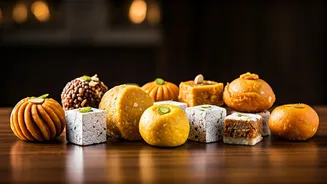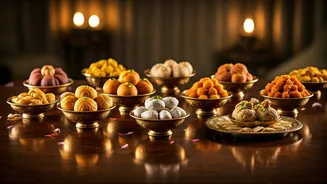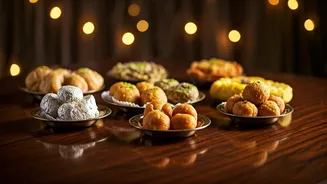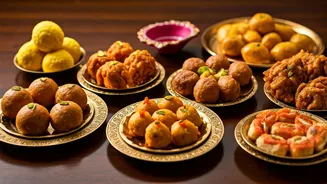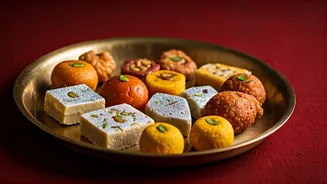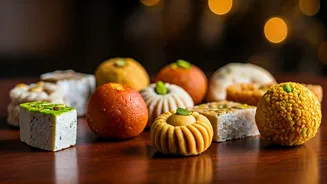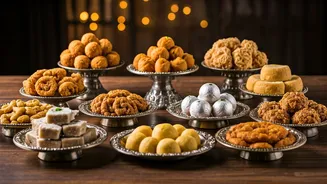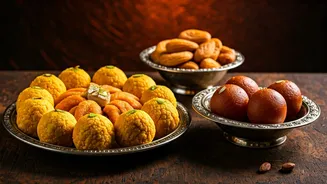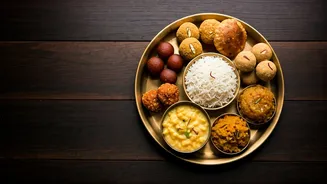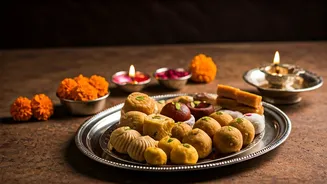The Divine Feast
Diwali, the festival celebrating the triumph of light over darkness, is a time of joy, family gatherings, and, importantly, offering prayers to the deities.
Central to these celebrations are the offerings (bhog) presented to Goddess Lakshmi, the goddess of wealth and prosperity, and Lord Ganesha, the remover of obstacles and the god of new beginnings. These offerings are not merely food items but are imbued with symbolic meaning and significance. They are believed to be instrumental in attracting blessings, fostering abundance, and ensuring a harmonious environment. Selecting the right foods is crucial, as each item carries a unique association with the deities, influencing the overall atmosphere of the celebrations.
Sweet Treats Abound
The first category of offerings involves sweet dishes, which are frequently presented to deities in various Hindu traditions. One such treat is Ladoo, which comes in several forms but is universally loved. It is believed that Ladoos, often spherical in shape, represent the sweetness of life and the blessings of Ganesha. Similarly, Motichoor Ladoo and Besan Ladoo are widely made as they are considered auspicious. Another popular treat is Kheer, a creamy rice pudding often flavored with cardamom, nuts, and saffron. Kheer is considered an auspicious dish for religious ceremonies and is believed to bring good fortune. Also, it's common to offer Barfi, a milk-based sweet made with condensed milk and sugar. It is usually flavored with cardamom and nuts and comes in various forms. These sweets highlight the celebration's spirit and devotion.
Savory Offerings Too
While sweets take center stage, savory dishes also have their place in the Diwali offerings. One of the most popular is Poha, a flattened rice dish. Poha is easy to prepare and is often seasoned with mustard seeds, curry leaves, and spices, representing simplicity and purity. Another savory offering is Puri-Sabzi, consisting of deep-fried puffed bread (Puri) served with a vegetable curry (Sabzi). This combination is often enjoyed as a celebratory meal, signifying abundance. Another food offered during Diwali is the classic Kachori, a deep-fried pastry filled with savory filling, such as lentils or potatoes. These items enrich the offering and highlight the culinary variety of the festival.
Fruits and Nuts
Fresh fruits are considered very auspicious, especially during Diwali. Fruits such as bananas and pomegranates are frequently offered to deities. Bananas, with their simplicity, symbolize abundance and the cyclical nature of life. Pomegranates, with their many seeds, represent prosperity and fertility, aligning with the core themes of the festival. In addition to fruits, various nuts, such as cashews, almonds, and pistachios, are offered to symbolize wealth. These are seen as luxury items, which represent the blessings of wealth and the promise of a prosperous year ahead. Including these fruits and nuts in the offerings reflects an appreciation for nature's gifts and a desire for a bountiful future.
Betel Leaf and Paan
Betel leaf, or Paan, holds a special place in Indian culture and is often included in offerings to the deities. Paan is believed to purify and freshen the mouth and is offered as a symbol of respect and hospitality. The inclusion of Paan in Diwali offerings signifies reverence and gratitude. The ingredients, such as betel nuts and spices, are often added to enhance the sensory experience. Its consumption after the Puja is seen as a gesture of honoring the deities' blessings. This custom reflects the importance of ritualistic practices in the Diwali celebrations.
Importance of Milk
Milk and milk-based products are considered sacred and are often used in rituals during Diwali. Milk symbolizes purity, nourishment, and abundance. Many households offer milk or dishes made with milk, such as sweets and kheer. Its significance is rooted in the belief that it purifies the surroundings and attracts positive energy. The act of offering milk symbolizes a dedication to the divine and a desire for health and prosperity. Furthermore, in some regions, milk is poured over the deities during the ceremony to bless the household. Milk underscores the purity and sanctity of the Diwali celebrations.
Lighting Lamps and Diyas
Although not an edible item, Diyas (oil lamps) play a central role during Diwali, representing the victory of light over darkness. Before the preparation of the food offerings, homes are decorated with numerous Diyas. These lamps are placed strategically, including the areas where offerings are kept, thereby illuminating the path for the deities. The flames of the Diyas symbolize knowledge, hope, and the presence of the divine. They guide us toward the blessings of the deities. Lighting the lamps is an essential part of creating a spiritual and inviting environment.
Preparing with Devotion
The method of preparing the offerings is just as crucial as the food items themselves. Foods are typically prepared with utmost care and devotion, symbolizing the cook's dedication to the deities. The act of preparing the food should be done with a clean heart and mind, maintaining the sanctity of the ritual. Many households observe dietary restrictions, such as abstaining from certain ingredients or using specific utensils for food offerings. These practices enhance the spiritual experience and represent a commitment to purity. The preparations reflect the reverence and respect shown towards the deities.
Shared Feast, Blessings
After the offerings have been presented to the deities, the food is often distributed among family members and friends. The sharing of the Prasad is a communal act that reinforces bonds and spreads blessings. This act strengthens community ties and promotes togetherness during the festive occasion. The food, believed to be infused with divine blessings, is consumed to gain prosperity, good health, and overall well-being. It also celebrates the values of sharing and compassion, which are central themes of Diwali. Sharing the feast is a symbol of gratitude and generosity.
